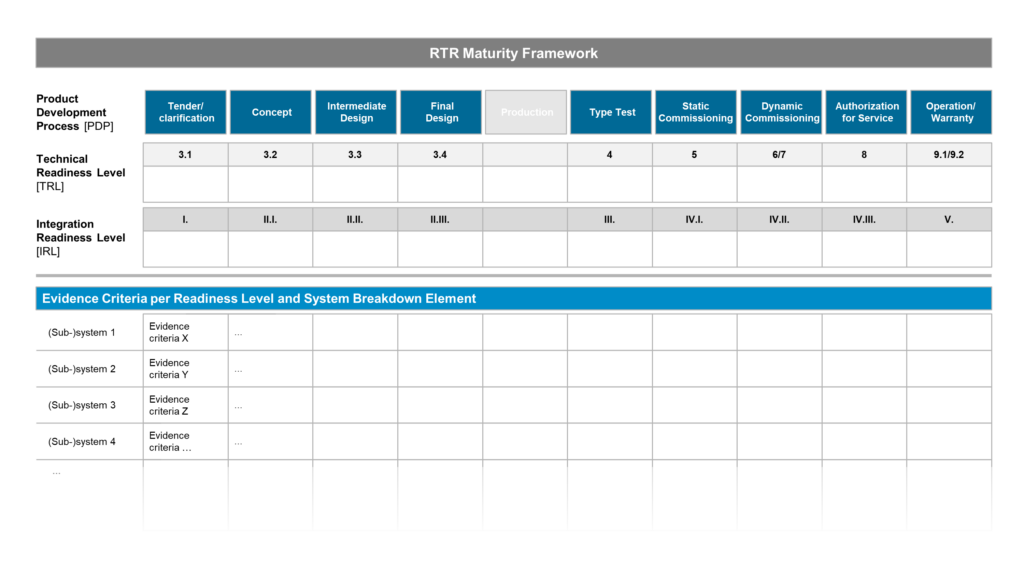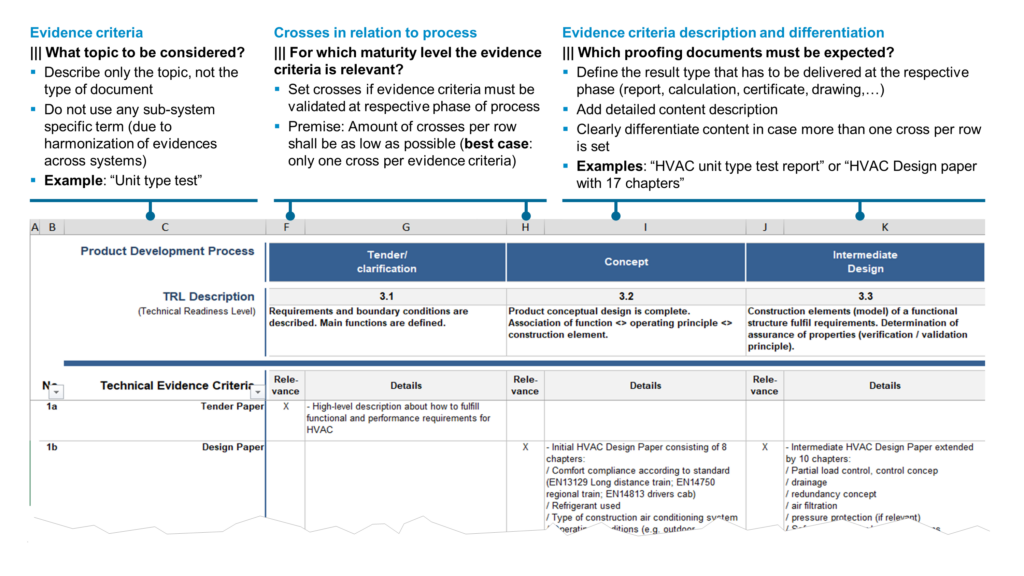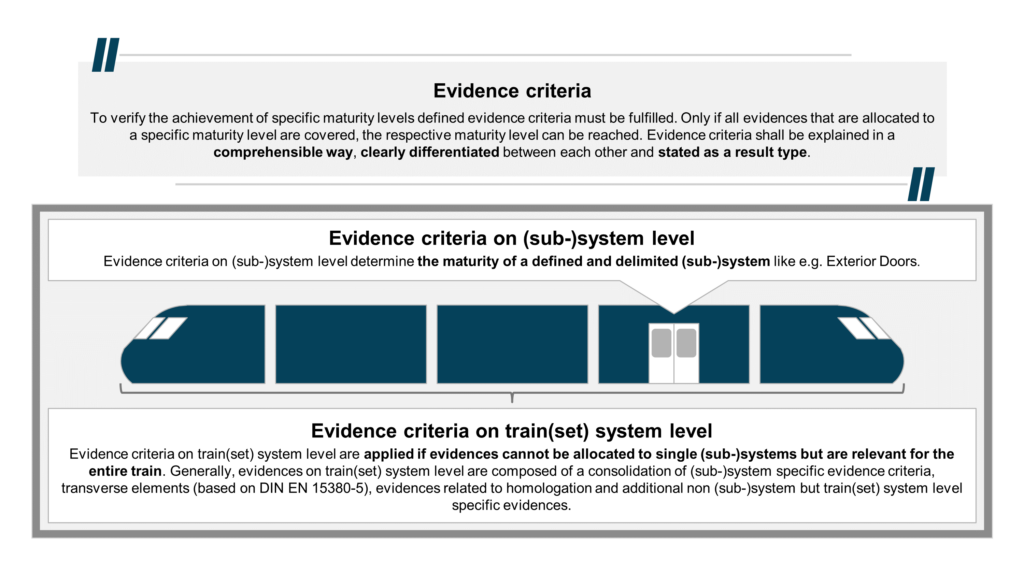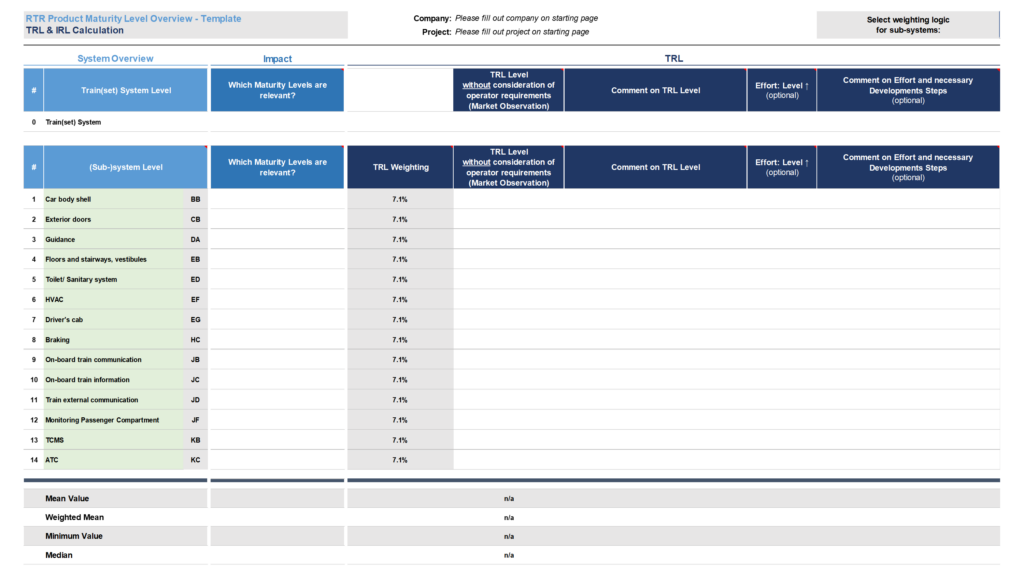
WP 04 – Maturity Model
Overall Context
Development of a generally accepted (voluntary) maturity model framework
With respect to Work Package 04, the RTR Initiative aimed to create a comprehensive and generally accepted (voluntary) maturity model framework as a basis to simplify future rolling stock tender procedures.
At the moment, companies within the railway industry apply company specific maturity model approaches, which lead to non-uniform definitions of maturity levels and related proofs of evidence. This may result in higher tender costs on both, operator and supplier side as well as incorrect technical risk assessment with correlated higher time impact.
Results of this work package shall ultimately lead to a sustainable enhancement of the cooperation and communication between a rolling stock supplier and its buyer by establishing a unique maturity model framework, which shall improve the comparability of different product maturity level information across relevant (sub-)systems and the train(set) system level as well as the coordination between supplier and buyer and the decision-making processes within a procuring organization.
Being part of the overall RTR Initiative, results from this Work Package have been developed according to the RTR-compliance mechanism (Antitrust-Council).
Documents about Maturity Model
To download the documents, please log in.
Objectives
Enhance cooperation and communication with regard to a uniform maturity assessment
The RTR maturity model can form the basis for developing an industry-wide framework regarding the assessment of train products’ development stages, which may principally range from a basic idea at one end to ready-for-market models that have been tested in real-life operational environments on the other hand.
In that context, the overall intention is to enhance the cooperation and communication between operator and supplier with regard to a uniform maturity assessment and to establish transparency and comparability.
Both industry sides benefit from various optimization levers that can be achieved by implementing and applying the RTR maturity model framework, such as:
- Establishing a common understanding and language about maturity model and applied terms/ definitions
- Applicability of a unique model by all affected parties, operators, suppliers and even sub suppliers
- Further development of an accepted industry-wide framework for self-assessment and management of maturity levels of rolling stock and its (sub-)systems, allowing sustainable evolution of individual (sub-)systems and ensuring higher reliability
- Reduced adjustment effort based on reusability of the maturity model
- Increased transparency regarding product maturity information, even at early stages and tender-independent phases of the product development and procurement process between supplier and operator
- Simplified and reduced coordination and communication effort between supplier and operator
- Reduction of potentially redundant validation work
- Improved clarity about maturity evidence that may get more clearly communicated along the supply chain to sub-suppliers
- Potential higher reliability from the start of the operation and lower cost and risk levels
Introduction to the maturity model
Guiding framework to structure the maturity assessment
In the following, the RTR maturity model framework will be described, which represents the core of the developed Work Package 04 results, since most respective deliverables are based on that guiding framework (see Figure 1).

Definition: A maturity model aims to determine the development status of complex systems in a transparent and comprehensible way by displaying various readiness levels during the phases of a product development process. To achieve a readiness level, various evidence must be proofed. The degree to which these requirement stages are fulfilled determines the system’s maturity.
Derived from: VDB-Guideline, Quality Engineering during Design phase of Rail Vehicles and Rail Vehicle Systems, Verband der Bahnindustrie in Deutschland (VDB) e.V., 09/2015
To verify the achievement of specific maturity levels, defined evidence criteria need to be fulfilled. Only if all evidence assigned to a specific maturity level are covered, the respective maturity level can be reached. Evidence criteria are characterized as result types, for example test reports, documentations, or certificates (see Figure 2). Evidence criteria have been developed based on defined development guidelines to ensure overall consistency.

The model assesses the maturity at different levels for individual (sub-) systems as well as for the train(set) system (see Figure 3). Especially during the tender process, the maturity model assessment is always based on the defined voluntary basic requirements of Work Package 01 and additional individual customization requirements addressed by tender issuing party.

To facilitate application through all phases of the procurement and product development process, an Excel tool has been developed (see Figure 4). The Maturity Level Overview Template allows a comprehensive overview of all maturity levels. Further, all information contained in this document serves as basis for bilateral discussion between operator and supplier prior to, during or after a tender process. The template supports information exchange of maturities for a train and its systems between operator and supplier. Interpretations of information and its translation into effects on cost and time remain in the individual responsibility of each company.

